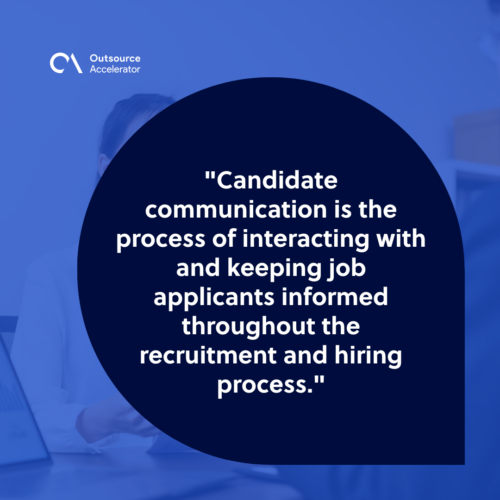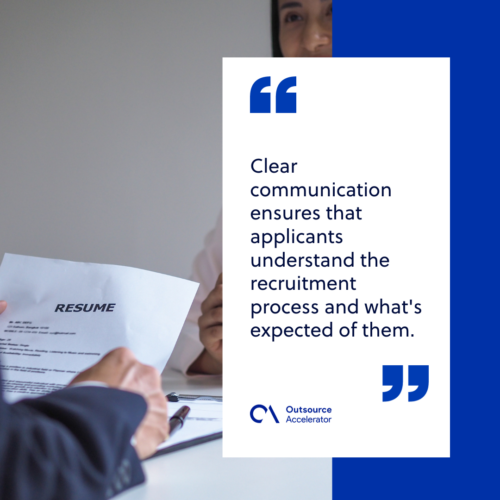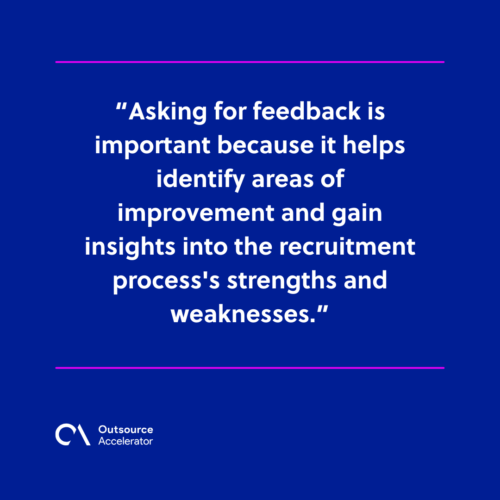10 steps to effective candidate communication

Effective candidate communication is the lifeblood of successful recruitment. It’s not just about finding the right people — it’s about building positive relationships throughout the hiring process.
According to a study by Business Wire, candidate communications are one of the most important factors for talent today.
This guide shows what candidate communication entails and why it matters. It will also provide you with a comprehensive ten-step guide to master this crucial aspect of recruitment.
What is candidate communication?
Candidate communication is the process of interacting with and keeping job applicants informed throughout the recruitment and hiring process.
This approach involves clear and timely communication to provide updates and feedback and to address any concerns that candidates may have.

Why a strong candidate communication strategy matters
Having a robust candidate communication strategy is essential for several reasons.
First, effective communication with applicants helps build trust and rapport.
When candidates feel that their time and efforts are respected and they are kept informed and involved, they develop a positive perception of the organization and its hiring process.
Furthermore, lack of communication or delayed updates can lead to frustration and disengagement among applicants.
Waiting for extended periods without any response can create uncertainty. It could cause candidates to lose interest and search for other opportunities.
Transparent and consistent communication throughout the process:
- Helps mitigate frustration
- Keeps candidates engaged
- Increases the likelihood of a successful hire
Effective candidate communication provides employers with valuable assessments and insights that inform decision-making.
By maintaining open lines of communication, companies can gain a deeper understanding of the applicant’s experience and perception.
Solicited feedback can improve recruitment and hiring, enhancing future decision-making and organizational effectiveness.
By communicating effectively, organizations clarify job expectations, show respect for applicants’ time, and improve candidate experience.
Advantages of candidate communication
Implementing a candidate communication strategy brings several benefits to organizations:
- Improves candidate experience. Clear and regular communication ensures applicants feel valued and informed. This leads to a positive experience for them, regardless of the outcome.
- Better-qualified applicants. Candidates who understand the role and company culture are more likely to be well-suited for the position. As a result, there are fewer mismatches and quicker onboarding.
- Enhances employer brand. A powerful candidate communication strategy contributes to a positive employer brand. This boosts the likelihood of attracting top talent.
- Reduces time-to-fill. Clear communication ensures that applicants understand the recruitment process and what’s expected of them. This can streamline the hiring process, reducing time-to-fill positions.
- Increased candidate engagement. Regular updates and feedback keep candidates engaged and interested in the job opportunity. This leads to a more active and responsive applicant pool.
- Greater diversity. Inclusive and clear communication encourages candidates from diverse backgrounds to apply, enriching your talent pool.
- Better efficiency. Applicants who understand the process and expectations are likelier to follow instructions, which can streamline the selection process.

10 steps for a powerful candidate communication strategy
Let’s explore ten steps for building a powerful candidate communication strategy:
1. Create a realistic job description
Crafting a clear and realistic job description sets expectations for both the organization and the candidates.
It helps attract job seekers who align with the role’s requirements, minimizing the chances of miscommunication or mismatched expectations later on.
For instance, provide specific examples of key tasks and deliverables instead of listing general responsibilities.
By avoiding overly vague language that may lead to confusion, applicants can better understand the role and determine their suitability.
Indeed reported that 52% of job seekers claim the job description quality is very influential on their decision to apply for a role.
2. Confirm each application
Acknowledge each candidate’s application promptly, preferably with an automated confirmation email.
This assures them that their application has been received and helps manage their expectations while awaiting further communication.
3. Plan out your primary touchpoints
Identify the key stages of your recruitment process and plan the main touchpoints for communication.
Clearly define when candidates can expect updates, feedback, and next steps. This also helps assure them and reduces anxiety or confusion.
For example, notify shortlisted candidates within two weeks after the initial screening.
The interview stage could consist of two rounds, and feedback on applicants’ performance could be provided within five business days.
4. Share the recruitment and hiring timeline
Transparency is crucial in candidate communication. Share the overall recruitment and hiring timeline, including tentative dates for interviews, assessments, and final decisions.
This allows applicants to plan accordingly and provides them with a clear understanding of the process.
For instance, relay to an applicant that the recruitment process is expected to be completed within a month.
When planning the recruitment timeline, consider the impact on job seekers. Using phone calls for milestone updates adds a personal touch and engages candidates.
5. Give status updates
Regular status updates are vital to keep candidates informed about their progress in the recruitment process.
Inform them about the next steps, any changes in the timeline, or if there are delays due to unforeseen circumstances. This shows respect and helps applicants feel engaged and valued.
In a professional setting, clear status updates are crucial for the communication process with job candidates.
Maintaining transparency and respect in messages, even when delivering unfortunate news to rejected candidates, is vital.
6. Be prepared to address concerns promptly
Candidates may have questions or concerns during the recruitment process. Respond to inquiries promptly and provide accurate and helpful information to address their concerns.
Prompt and reliable communication helps build trust and assures candidates that their voices are heard.
7. Tailor messages sent to applicants
Personalize your communication whenever possible. Address candidates by their name and reference specific details from their application or interactions.
This personal touch demonstrates that you value their individuality and effort.
Refer to this template as a guide:
“Dear [name of applicant], we are impressed at your experience with reputation management. We are specifically amazed at your success in mitigating the unfounded rumors laid against your previous employer.
We would like to invite you for an interview to discuss this further.“
8. Take advantage of text messaging
Think about using text messaging to provide reminders, scheduling, and quick updates.
Text messages have high open rates and can quickly reach candidates, especially when time-sensitive communication is required.
For instance, send an SMS reminder about an upcoming interview with instructions to confirm an applicant’s availability.
9. Be considerate with rejection letters
Rejection is inevitable in the recruitment process. Nevertheless, employers can alleviate the negative impact by sending rejection letters with empathy and respect.
Provide constructive feedback when possible and encourage candidates to apply again in the future.
Consider this sample:
“Thank you for your interest in the position of [role] for [organization]. After careful consideration, we have decided to move forward with other candidates whose skills more closely align with the role we are looking to fill.
We appreciate the effort you put into your application and encourage you to apply for future opportunities with us.“
10. Ask for feedback
At the end of the recruitment process, ask applicants for their feedback on their experience.
When it comes to fostering candidate engagement, seeking feedback is a crucial step in the recruitment process.
Ask for feedback at the right moment, such as after an interview or after a candidate has completed the application process. Don’t wait too long, as applicants may lose interest or forget important details.
Organizations can offer different ways to provide feedback. This could include email surveys, online forms, or even phone interviews.
In addition, firms can give candidates the option to provide opinions anonymously. Some may be more candid if they know their responses won’t be tied to their identity.
Asking for feedback is important because it helps identify areas of improvement and gain insights into the recruitment process’s strengths and weaknesses.

More tips for building a strong candidate communication strategy
Here are a few additional tips to consider when developing your candidate communication strategy:
- Treat candidates like customers. Provide exceptional customer service throughout the recruitment process, treating candidates with respect and professionalism.
- Always be available. Respond promptly to candidate inquiries and concerns. It shows that you value their time and effort.
- Be careful with your language. Use clear and concise language in all communication to avoid confusion or misunderstandings.
- Humanize your communication. Make an effort to use applicants’ names, mention specific details from their applications or interactions, and show genuine interest in their background and qualifications.
- Establish and foster a talent community. Engage with candidates even after the recruitment process ends. This helps build a talent pipeline and maintains relationships for future opportunities.
- Use technology to automate communication. Leverage applicant tracking systems (ATS) or other tools to automate communication and ensure consistency in messaging.
- Build a positive employer brand. Incorporate your company’s values and culture into your communication to showcase what makes it a great workplace.
- Provide training to the recruitment team. Train your recruitment team on effective communication techniques, emphasizing active listening and empathy.
- Incorporate employee testimonials. Sharing employee testimonials can show the authenticity of the company’s culture and values. Providing a behind-the-scenes look at the work environment can help candidates envision themselves within the team.
- Create a candidate communication calendar. A communication calendar outlining when and how applicants will receive updates can be very helpful. The calendar can include details such as when candidates should expect to hear about interview schedules, assessment results, or any changes in hiring timelines.
- Show gratitude. Thanking candidates for their time is essential to building a positive candidate experience. Whether the applicant is successful in the hiring process or not, thanking them for their interest and time shows that the organization values each candidate.
- Regularly evaluate and improve. Continuously assess your candidate’s communication strategy based on feedback and data. Make adjustments as needed to meet the evolving needs of applicants.







 Independent
Independent




